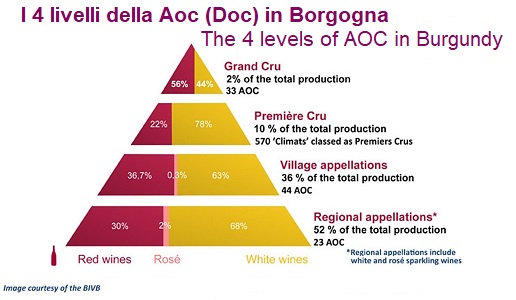Burgundy’s Top Premier Cru: an historic error?

Technically speaking Premier Cru are a step below the Grand Cru in Burgundy’s quality pyramid. However, their quality is sometimes the best in their area.
The classification of Burgundy wines, for both the Chardonnay-based whites and Pinot Noir-based reds, and excluding the so-called ‘interior’ varietals like Aligoté for the whites and Gamay for the reds, is quite easy to understand:
-
Grand Cru: these wines are currently from 33 vineyards in Burgundy and represent only 2% of the region’s production. The names of the Grand Cru vineyards are so well-known that the names of the village they are in is not on the wine’s label, only that of the vineyard.
-
Premier Cru: this classification is for wines from 562 Burgundy vineyards and represent some 11% of the region’s production. The name of the vineyards is on the label immediately after that of the village and its classification (the latter is not obligatory. Madame Leroy, for example, indicates the Cru only when it is Grand).
-
Appellation Village: this is considered to be the first classification for base wines and the label has the name of the village it is from and is exclusively reserved for wines produced in a specific location established by regulations.
-
Appellation Régionale: the denomination Bourgogne on a label indicates wines made from grapes from different villages in the region and they are often blends of grapes from different villages. Then there are the Blanc or Rouge classified wines.
At the base of the classification is the premise that in Burgundy the terroir is a fundamental element in the production of wine and here, as nowhere else in the world, the respect of the characteristics and differences of individual vineyards is paramount for winemaking.
Thus the classification system would appear to be very simple, progressively linear without any apparent doubt in regard to value. In reality, Burgundy has a “euphony” of quality and the amateur runs the risk of getting trapped in a dangerous and, at times, incomprehensible labyrinth. A great, determining and important factor for quality is “the touch”, the almost artistic skill of the winemaker in interpreting the two key grapes. Strange as it may seem, even the French can make mistakes and, over time, it has been tragically realized that some cru wines of a lower classification were better than a superior one be it for the skill of the winemaker in exploiting the potential of his grapes, be it for the fact that some areas were “neglected” when the classification was drawn up have proved to be splendid producers of sensorial wonders as winemaking evolved.
And these “historic errors” are what we will be looking at, above all the Premier Cru, the second tier of quality, as well as some Lieu Dit and Climat. These are legendary wines and many are very rare while their irreproachable quality is such that they are coveted and sold at prices that make them not only exclusive but difficult to find also because international wine critics and wine lovers consider them to be better than many of the Grand Cru wines.
This “treatise” has been divided into different installments because it was not possible to “study” the subject in one go without stressing the body and soul and spoiling the enjoyment of drinking these wine masterpieces.

 Italiano
Italiano







